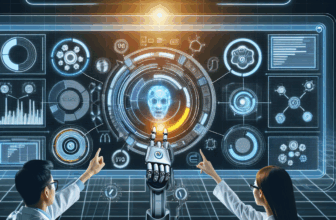Enhancing Customer Experience: The Power of Personalized Journey Mapping with AI
Table of Contents
- Introduction
- Understanding Customer Experience
- What is Journey Mapping?
- The Role of Personalization in Customer Experience
- The Science of AI in Journey Mapping
- Case Studies: Real-World Applications
- Challenges and Considerations
- Future Trends in Personalized Journey Mapping
- Conclusion
- FAQ Section
- Resources
- Disclaimer
Introduction
In today’s highly competitive market landscape, enhancing customer experience (CX) has become paramount for businesses aiming to sustain growth and build lasting relationships with their clients. Traditional methods of customer engagement often fall short in meeting the dynamic needs of consumers, leading organizations to explore more innovative approaches. One such approach is the integration of artificial intelligence (AI) into personalized journey mapping. This article delves into the transformative effects of AI-driven personalized journey mapping on customer experience, detailing its significance, implementation, challenges, and future trends.
Understanding Customer Experience
2.1 Defining Customer Experience
Customer Experience refers to the holistic perception that customers develop through their interactions with a brand throughout the entire customer lifecycle. This encompasses every touchpoint, from initial consideration and purchase to post-purchase support and beyond. Defining customer experience involves understanding not only the service or product quality but also the emotions and sentiments evoked during these interactions.
2.2 Importance of Customer Experience
The importance of customer experience cannot be overstated. A positive experience significantly boosts customer retention, loyalty, and advocacy, which in turn leads to improved financial performance. Statistics show that businesses that prioritize customer experience see a 60% increase in customer satisfaction scores and are more likely to turn first-time buyers into returning customers.
What is Journey Mapping?
3.1 The Journey Mapping Process
Journey mapping is a strategic process that involves creating visual representations of a customer’s journey through various stages of interaction with a brand. This process typically includes identifying key touchpoints, mapping customer emotions and actions, and highlighting pain points and opportunities for improvement. The subsequent insights gained from analyzed journey maps can drive more informed decision-making across departments.
3.2 Benefits of Journey Mapping
Effective journey mapping can lead to numerous benefits, including better alignment of customer objectives with business goals, increased transparency in customer interactions, and improved opportunities for personalization. By understanding the customer journey thoroughly, organizations can identify areas for enhancement, streamline processes, and ultimately nurture a more satisfying customer experience.
The Role of Personalization in Customer Experience
4.1 Understanding Personalization
Personalization in customer experience refers to the tailoring of services, products, and communications to meet the specific needs and preferences of individual customers. This can involve anything from personalized email marketing campaigns to curated product recommendations based on past purchases or browsing behavior.
4.2 Strategies for Personalization
Businesses can employ various strategies for personalization, including data-driven approaches leveraging customer data, segmentation techniques, and targeted marketing campaigns. Furthermore, engaging with customers to gather feedback can enhance the personalization process, allowing businesses to adapt quickly and effectively to changing preferences.
The Science of AI in Journey Mapping
5.1 How AI Enhances Data Collection
AI plays a pivotal role in enhancing data collection for personalized journey mapping. By utilizing machine learning algorithms and natural language processing, businesses can analyze vast volumes of data to gain actionable insights. AI can streamline data collection processes, predicting customer needs and behaviors more efficiently than traditional methods.
5.2 Predictive Analytics in Personalization
Predictive analytics, fueled by AI, enables companies to anticipate client needs before they even arise. By analyzing historical customer data and trends, businesses can develop targeted strategies that improve the customer journey, ensuring a proactive rather than reactive approach to engagement.
Case Studies: Real-World Applications
6.1 Case Study 1: Retail Giant
One notable example is Amazon, which uses personalized journey mapping combined with AI to refine the customer experience. By analyzing user behavior, Amazon provides tailored product recommendations, which drive higher conversion rates. The company also uses predictive analytics to optimize inventory and personalize marketing messages, demonstrating the profound impact of AI and journey mapping.
6.2 Case Study 2: Financial Services
Another compelling case is that of Chase Bank, which implemented journey mapping techniques enhanced by AI. The bank developed a personalized onboarding experience that guides new customers through the account setup process. Using AI, Chase evaluated customer behaviors and preferences to tailor the onboarding process, resulting in improved customer satisfaction and retention rates.
Challenges and Considerations
7.1 Data Privacy and Ethical Considerations
While personalization and AI offer remarkable opportunities for improving customer experience, they also raise significant data privacy and ethical considerations. Businesses must ensure customer data is handled responsibly, adhering to regulations such as GDPR and CCPA. Transparency about data usage, coupled with robust privacy practices, is vital to foster consumer trust.
7.2 Technological and Implementation Challenges
Implementing AI-driven personalized journey mapping poses several technological challenges, including data integration across platforms, ensuring consistency in branding, and training staff to navigate new technologies. Overcoming these barriers involves investing in the right technological infrastructure and fostering a culture of data literacy within organizations.
Future Trends in Personalized Journey Mapping
8.1 The Rise of Omnichannel Experiences
As customers increasingly demand seamless experiences across channels, the rise of omnichannel experiences will shape the future of personalized journey mapping. Businesses must ensure that their journey mapping initiatives accommodate diverse customer pathways, ensuring coherence and continuity between both online and offline touchpoints.
8.2 Integrating Emerging Technologies
Adopting emerging technologies such as augmented reality (AR), virtual reality (VR), and the Internet of Things (IoT) can further enhance personalization efforts. For example, retailers may utilize VR to create innovative and immersive shopping experiences, while IoT devices could provide unprecedented levels of customer insight and interaction.
Conclusion
In conclusion, personalized journey mapping powered by AI provides a comprehensive approach to enhancing customer experience. By leveraging AI's capabilities, organizations can craft tailored experiences that resonate with individual customers, driving loyalty and satisfaction. As businesses continue to evolve, understanding the future trends in this domain will be imperative. Moving forward, organizations should prioritize data privacy, technological integration, and continuous adaptation to meet the ever-changing expectations of consumers.
FAQ Section
Q1: What is journey mapping?
A1: Journey mapping is the process of creating visual representations of a customer's interactions with a brand throughout the customer lifecycle, enabling businesses to identify pain points and improve overall experience.
Q2: How does AI enhance personalization in customer experience?
A2: AI enhances personalization by analyzing large volumes of customer data to predict preferences, automate recommendations, and optimize touchpoints for a more tailored experience.
Q3: What are some challenges businesses face when implementing AI-driven journey mapping?
A3: Key challenges include data privacy concerns, technological integration, user training, and maintaining consistency across various customer touchpoints.
Resources
| Source | Description | Link |
|---|---|---|
| Harvard Business Review | Insights on customer experience and personalization | HBR |
| McKinsey | Report on AI and customer experience | McKinsey |
| Deloitte | Study on journey mapping and customer engagement | Deloitte |
| Forrester | Research on personalization strategies | Forrester |
| Salesforce | Guide to AI in customer experience | Salesforce |
Disclaimer
This article is produced by A.I. and is in Beta Testing. The information provided herein is for informational purposes only and should not be construed as professional advice. Use this information at your discretion and consult with relevant professionals as needed.
The article has aimed to provide an extensive overview of the power of personalized journey mapping with AI, highlighting critical aspects, real-world examples, and future considerations for businesses hoping to leverage these insights to improve customer experiences.










